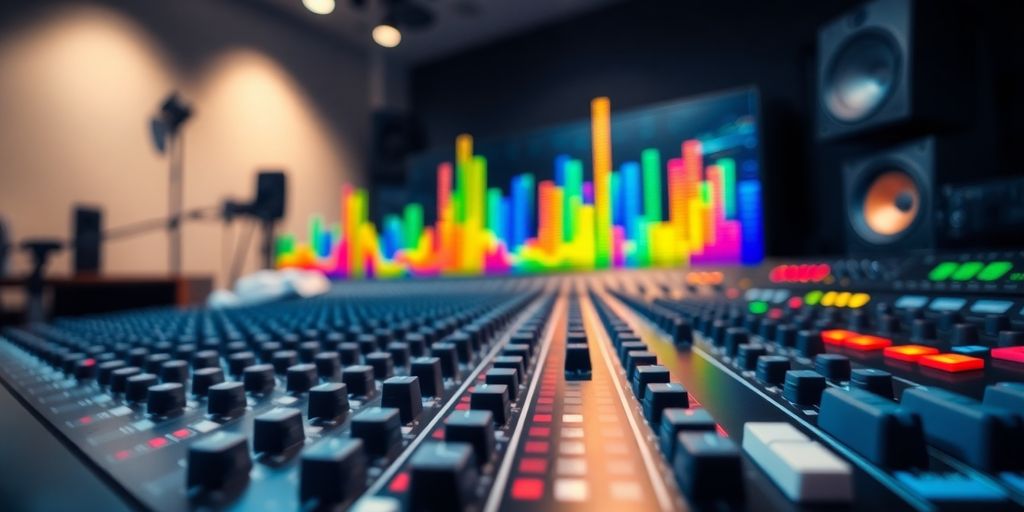
Ever wonder why some news reports just hit different, making you feel the urgency or the relief of a story? A lot of that comes down to the music. It’s not just background noise; it’s a big part of how news gets its message across. Good music for news can really change how you feel about what you’re watching.
Key Takeaways
- Music helps set the mood and guides what viewers feel when they watch the news.
- News programs use special sounds and tunes to create their own unique identity.
- Music is used in specific ways for different parts of a news show, like intros and transitions.
- Getting the sound right, with clear audio and good volume, is super important for news music.
- Composers pick instruments, rhythms, and harmonies to bring out certain feelings in the news.
Understanding the Core Purpose of Music for News
Setting the Right Tone and Atmosphere
Okay, so think about it: news isn’t just about facts; it’s about how those facts are presented. Music plays a huge role in setting the stage. It’s like the lighting in a movie – it can totally change how you feel about what you’re seeing. A somber piano piece? Instantly makes you think something serious is up. Upbeat tempo? Maybe it’s a feel-good story. It’s all about creating the right vibe from the get-go. It’s important to consider Canadian content regulations when selecting music.
Guiding Viewer Emotion and Perception
Music isn’t just background noise; it’s a manipulator of emotions. News producers know this. They use music to subtly guide how you react to a story. Think about those investigative reports – the music builds suspense, makes you feel like something big is about to be revealed. Or those human-interest pieces? The music tugs at your heartstrings, makes you empathize with the people involved. It’s a powerful tool, and it’s used very deliberately. Music can be used to create a perfect playlist for any occasion.
Enhancing Credibility and Professionalism
Let’s be real: a news broadcast with cheesy, generic music sounds, well, cheesy and unprofessional. Good music adds a layer of polish and credibility. It tells you that the news organization takes itself seriously, that it’s invested in delivering a high-quality product. It’s like the difference between a homemade website and one designed by a professional – the attention to detail matters. It’s all about building trust with the viewer.
Think of it this way: music is the unspoken language of news. It communicates things that words sometimes can’t. It sets the mood, guides your emotions, and ultimately, shapes your perception of the news itself. It’s a subtle art, but when done right, it can make all the difference.
Crafting the Sonic Identity of a News Program
Developing a Signature Sound Palette
Think of your news program’s music as its audible logo. It’s more than just background noise; it’s a carefully chosen set of sounds that instantly tells viewers what they’re watching. A signature sound palette involves selecting specific instruments, textures, and overall sonic characteristics that align with the program’s brand and target audience. It’s like choosing the right colors for a visual logo – each element contributes to the overall impression.
- Consider the emotional impact of different instruments. Strings can evoke seriousness, while electronic elements might suggest innovation.
- Experiment with different combinations of sounds to find something unique and memorable.
- Don’t be afraid to break away from traditional news music tropes if it suits your program’s style.
A well-defined sound palette helps create a cohesive and recognizable identity for your news program. It’s about making conscious choices that reflect the program’s values and personality.
Utilizing Thematic Melodies and Motifs
Just like a movie has a theme song, your news program can benefit from thematic melodies and motifs. These are short, memorable musical phrases that are associated with specific segments or the program as a whole. They act as audio cues, signaling to viewers what to expect. Think of it as musical shorthand. You can even create a custom hotel playlist to enhance the experience.
- Develop a main theme that represents the overall tone and message of the program.
- Create variations of the main theme for different segments, maintaining consistency while adding variety.
- Use motifs to highlight specific stories or recurring topics.
Ensuring Brand Consistency Across Segments
Consistency is key to building a strong brand identity. This applies to the music used in your news program as much as it does to the visuals and on-air talent. The music should maintain a consistent style and quality across all segments, from the opening theme to the background scoring during interviews. This doesn’t mean every piece of music has to sound exactly the same, but it should all fit within the established sonic framework. Think of it as a family of sounds, all related but each with its own unique characteristics.
- Establish clear guidelines for music selection and composition.
- Use a consistent set of instruments and sounds throughout the program.
- Maintain a consistent level of quality in all musical elements.
Strategic Application of Music in News Segments
Music in news isn’t just background noise; it’s a tool that, when used right, can really make a difference in how viewers understand and feel about the news. It’s about knowing when and how to use music to support the story, not distract from it. Think of it as the unsung hero that helps tie everything together.
Opening and Closing Theme Integration
Your opening and closing themes are more than just catchy tunes; they’re sonic branding. They immediately signal to the viewer what program they’re watching and provide a sense of familiarity. The opening theme needs to grab attention and set the tone for the broadcast, while the closing theme should leave a lasting impression and provide a sense of resolution. It’s like the bookends of your news program, framing the content within a consistent audio identity. Consider how sound in branding can boost recognition.
Transitional Cues for Seamless Flow
Transitions between news segments can be jarring if not handled well. Music can smooth these transitions, creating a more cohesive viewing experience. Short musical cues, often called stingers or bumpers, can signal a change in topic or location. These cues should be brief and tonally appropriate for the upcoming segment. For example, a lighter, more upbeat cue might be used to transition to a feel-good story after a serious report. It’s all about guiding the viewer’s ear and preparing them for what’s next.
Background Scoring for Visuals and Interviews
Background music during visuals and interviews can add emotional depth and context. However, it’s a delicate balance. The music should never overpower the spoken word or distract from the visuals. Instead, it should subtly enhance the mood and reinforce the message. For instance, somber music might accompany footage of a disaster, while hopeful music could underscore an interview with someone overcoming adversity. The key is subtlety and relevance. Think of it as adding a layer of emotional coloring to the story.
Using music effectively in news segments requires careful planning and execution. It’s not about throwing in any old tune; it’s about selecting the right music for the right moment to support the story and engage the viewer. When done well, music can elevate the news from a simple recitation of facts to a compelling and emotionally resonant experience.
Here’s a simple breakdown of how music can be used in different segments:
| Segment Type | Music Style | Purpose |
|---|---|---|
| Opening Theme | Bold, Energetic | Establish brand, grab attention |
| Breaking News | Urgent, Dramatic | Convey seriousness, create tension |
| Feature Story | Empathetic, Reflective | Enhance emotional connection, provide context |
| Weather Report | Upbeat, Informative | Maintain positive tone, provide a sense of normalcy |
| Closing Theme | Hopeful, Resolute | Leave a lasting impression, provide a sense of closure |
Technical Considerations for Optimal News Music

Achieving Clarity and Mix Balance
Getting the mix right is super important. You want the music to support the news, not drown it out. It’s a balancing act. Think about it like this: the music is the background, and the voices are the main focus. If the music is too loud, people will struggle to hear what’s being said. If it’s too quiet, it might as well not be there. It’s all about finding that sweet spot where everything works together. This is where sound engineering tips come in handy.
Mastering for Broadcast Standards
Broadcast standards are a real thing, and you gotta pay attention to them. Different networks have different rules about how loud your audio can be, and if you don’t meet those standards, your music might get rejected. It’s not just about loudness, either. It’s about making sure the audio sounds good on all kinds of devices, from tiny phone speakers to big TV sound systems.
- Check the specific requirements of the broadcast network.
- Use a reliable mastering service or software.
- Test the audio on different devices.
Dynamic Range and Loudness Control
Dynamic range is the difference between the quietest and loudest parts of your music. In news, you generally want to keep the dynamic range fairly narrow. You don’t want huge jumps in volume that can startle viewers. Loudness control is all about making sure the overall volume is consistent and meets broadcast standards. It’s a bit of a technical thing, but it makes a big difference in how professional your news broadcast sounds. Think of it as making sure no one has to constantly adjust the volume while they’re watching.
Keeping the dynamic range in check is key. You don’t want the music to be whisper-quiet one second and blasting the next. Consistent loudness helps maintain a professional and comfortable viewing experience.
The Role of Emotion in News Music Composition

Music in news isn’t just background noise; it’s a powerful tool for shaping how viewers feel and what they remember. It’s about finding the right balance – not being manipulative, but also not being emotionally flat. It’s a tricky line to walk, but when done well, it can really make a difference.
Evoking Urgency and Seriousness
When a story breaks, the music needs to reflect the gravity of the situation. Think minor keys, maybe some dissonant chords, and a tempo that keeps things moving without feeling rushed. The goal is to create a sense of importance and immediacy. It’s not about scaring people, but about making sure they understand the weight of what’s happening. For example, a story about a natural disaster might use low strings and sustained notes to create a feeling of unease and concern. It’s all about setting the right tone.
Conveying Hope and Resolution
It’s not all doom and gloom, though. News also covers stories of resilience, recovery, and positive change. The music here needs to lift spirits without feeling saccharine. Major keys, brighter instrumentation, and a more optimistic tempo can all help. Think about using a simple, memorable melody that suggests things are getting better. It’s about offering a sense of hope and resolution after a difficult story. It’s a reminder that even in tough times, there’s always light at the end of the tunnel.
Subtlety in Emotional Cues
This is where the real skill comes in. News music shouldn’t be hitting you over the head with emotion. It needs to be subtle, almost subliminal. The goal is to enhance the story, not distract from it. Think about using small changes in harmony or instrumentation to create a feeling, rather than relying on big, dramatic gestures. It’s about trusting the audience to pick up on the emotional cues without being explicitly told how to feel. It’s like adding a pinch of salt to a dish – you don’t want to taste the salt, but you’d miss it if it wasn’t there.
The best news music is the kind you don’t really notice, but that subtly shapes your perception of the story. It’s about creating an emotional landscape that supports the narrative without overpowering it. It’s a delicate balance, but when it works, it’s incredibly effective.
Selecting the Right Musical Elements for News
Instrumentation Choices for Impact
Picking the right instruments can really change how people feel about a news story. A piano might bring a sense of reflection, while strings could add drama. Think about what emotion you want to create and choose instruments that match. For example, a story about economic hardship might use somber, low-frequency instruments, while a piece on scientific discovery could benefit from brighter, more optimistic sounds. It’s all about making the music fit the message.
Rhythmic Pacing for Narrative Drive
The rhythm of the music should match the pace of the news story. A fast-paced rhythm can create a sense of urgency, perfect for breaking news. A slower rhythm can help viewers reflect on more serious topics. Consider how the radio script’s core components work together to create the right mood. It’s like setting the speed of a car – too fast, and you lose control; too slow, and you lose interest. The goal is to keep the viewer engaged without overwhelming them.
Here’s a simple guide:
- Fast Tempo (120+ BPM): Breaking news, developing stories, sports highlights
- Medium Tempo (90-120 BPM): General news, interviews, feature stories
- Slow Tempo (60-90 BPM): Investigative reports, human interest pieces, obituaries
Harmonic Structures for Emotional Depth
The chords and harmonies you use can add layers of emotion to the music. Major chords often sound happy and hopeful, while minor chords can create a sense of sadness or tension. Using dissonant chords can add a feeling of unease, which might be good for stories about conflict or danger. It’s like adding spices to a dish – the right amount can make it amazing, but too much can ruin it. Think about how the music press release can help you understand the emotional impact of your music.
Harmonic structures are the backbone of emotional storytelling in music. By carefully selecting chord progressions and voicings, composers can subtly influence the viewer’s perception of the news, adding depth and nuance to the narrative.
Future Trends in Music for News Broadcasts
Adaptive Scoring and AI Integration
Okay, so picture this: news music that changes on the fly, reacting to the actual story being told. That’s where things are headed. AI is starting to play a big role, analyzing the tone and content of news segments and then creating music that fits perfectly. It’s not just about generic background music anymore; it’s about music that’s tailored to each specific news piece. Think of it like a smart soundtrack that evolves with the news as it unfolds. It’s pretty wild, right?
Personalized Audio Experiences
Ever thought about getting your news with a soundtrack that you helped pick? It sounds strange, but it could happen. The idea is that news outlets might start offering different musical styles or even letting you adjust the intensity of the music. Maybe you want something upbeat for the morning news or something more serious for evening reports. It’s all about making the news experience more engaging and relevant to each individual viewer. It’s like choosing your own background music for the day’s headlines.
Immersive Soundscapes for Digital News
News isn’t just on TV anymore; it’s everywhere – phones, tablets, computers. And with that comes the chance to do some really cool things with sound. Instead of just basic background music, we could see news stories using full-on soundscapes that put you right in the middle of the action. Imagine hearing the sounds of a protest while reading about it, or the gentle hum of a hospital while getting an update on a health crisis. It’s about creating a more immersive experience that grabs your attention and makes you feel more connected to the story.
The future of news music is all about being more dynamic, more personal, and more immersive. It’s about using technology to create a deeper connection between the news and the viewer, making the experience more engaging and impactful. It’s not just background noise anymore; it’s an integral part of the storytelling process.
Wrapping It Up
So, there you have it. Getting the right music for news isn’t just about picking a catchy tune. It’s about making sure that music helps tell the story without getting in the way. Think about the mood, the pace, and how it all fits together. When it’s done well, you might not even notice it, but it’s definitely doing its job. It’s a pretty cool skill to have, making sounds that just click with what’s happening on screen. Keep experimenting, and you’ll find what works best.
Frequently Asked Questions
Why is music important for news shows?
Music in news helps set the mood, guides how viewers feel about the stories, and makes the broadcast seem more trustworthy and professional. It’s like the background score in a movie, but for real-life events.
How do news programs get their own unique sound?
News programs create their own special sound by picking certain instruments and sounds that fit their brand. They use short musical tunes for different parts of the show to make sure everything sounds consistent and familiar to viewers.
Where is music typically used in a news broadcast?
Music is used at the start and end of news shows, and also between different story parts to make everything flow smoothly. It also plays softly in the background during videos or interviews to add to what’s being shown or said.
What technical things are important for news music?
Making sure the music is clear and mixed well is key. It also needs to meet broadcast rules for how loud it can be and how much it changes in volume, so it sounds good on everyone’s TV or radio.
How does music make people feel certain emotions during the news?
Composers use music to make viewers feel things like urgency or seriousness, but also hope and solutions. They do this in a subtle way, so the music supports the story without being too distracting.
What parts of music are chosen for news?
The choice of instruments, the speed of the music, and the way chords are put together all help tell the story and create the right feeling. Each element plays a part in making the news music effective.





